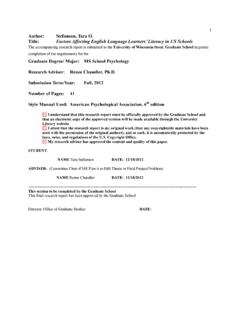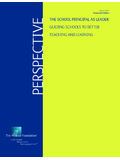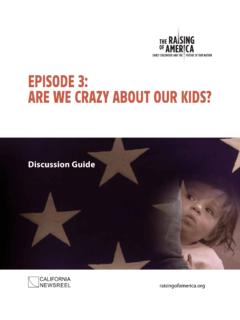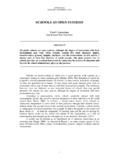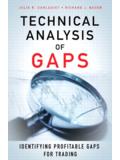Transcription of Facts About Kids and Reading
1 Facts About kids and Reading ACHIEVEMENT Facts : Only one-third of all students entering high school are proficient in Reading only About 15 percent of African American students, and 17 percent of Hispanic students. (NAEP Reading_2009) Two thirds of eighth graders do not read at grade level (proficient). (NAEP Reading_2009)There is a significant economic Reading gap for students: only 16 percent of students eligible for free or reduced lunch programs are proficient in Reading , compared to 42 percent who are not eligible. (NAEP Reading_2009) Boys lag behind girls in Reading proficiency in all 50 states in some states by as many as 10 percentage points.
2 (Center for Education Policy)Between 1971 and 2004, the NAEP scores of 12th-graders showed no improvement. Further, the 2005 scores of 12th-graders were generally lower than their counterparts in 1992. (Alliance for Excellent Education) Only 31 percent of college graduates have high level literacy skills. (2003 National Assessment of Adult Literacy, cited by The New York Times) 47% of students who took the ACT s in 2009 did not meet the ACT College Readiness for the Reading section of the ACT Benchmark. (the ACT)A study conducted in 2005 revealed that 33% of non-college students and 29% of college students who participated in the study felt inadequately prepared for Reading and understanding complicated materials.
3 (Achieve, Inc.)In a 2005 study, 70% of 300 surveyed college instructors felt that students were unprepared to understand college level Reading and comprehending complex materials.(Achieve, Inc.) The 2009 SAT results revealed that students who had four or more years of English and Language Arts study scored over 100 points more in Critical Reading , Writing and Mathematics sections than students who had one year or less training. (The CollegeBoard)In 2008, California reported that only one-third of students who graduated from California public schools were prepared to go to a 4-year college. (The Center for Future of Teaching and Learning) Facts About kids and HAPPENS IF kids DON T LEARN TO READ AND READ WELL:The Coalition for Juvenile Justice (2001) reports that 82 percent of prison inmates are high school dropouts, and a very high proportion of them cannot read.
4 (Adolescent Literacy: A National Reading Crisis)More than one third of all juvenile offenders read below the fourth-grade level. (Adolescent Literacy: A National Reading Crisis) Every school day in America, 3,000 students drop out the majority of them are poor readers. Students with below grade level Reading skills are twice as likely to drop out of school as those who can read on or above grade level. (Adolescent Literacy: A National Reading Crisis) About one-third of all first-year college students took a remedial course in Reading or math in 2007-2008. Students taking remedial Reading classes in college had only a 17 percent chance of graduating, according to 2004 DOE data.
5 ( Department of Education data, cited by USA Today) Forecasts that by 2018, 63 percent of all jobs will require at least some postsecondary education. Employers will need 22 million new workers with postsecondary degrees and the report shows that we will fall short by three million workers without a dramatic change in course. This translates into a deficit of 300,000 college graduates every year between now and 2018. (Georgetown University, Center on Education and the Workforce)Forecasters have predicted that if static literacy levels continue, then by 2030 the entire Literacy Level distribution of the population will have decreased, creating an American workforce that is unequipped and unskilled to work in the demanding global market.
6 (Educational Testing Service)In 2008, the California State University System, the largest university system in the country, recorded that more than 60% of its incoming freshmen student s required remedial coursework in English. (The Center for Future of Teaching and Learning.) It was estimated that a single state s employers will have to pay almost $40 million a year to provide remedial training in Reading , writing, and mathematics to its employees if the current trends in secondary school preparation continue. (Achieve, Inc.)The United States placed 16th out of 21 OECD (Organization of Economic Co-Operation and Development) countries surveyed for high school graduation rates.
7 (Educational Testing Service) Facts About kids and adults at the lowest level of literacy proficiency, 43% live in poverty. Among adults with strong literacy skills, only 4% live in poverty. (First Book) Low literacy costs $73 billion per year in terms of direct health care costs. This is equal to the amount Medicare pays for physician services, dental services, home health care, drugs, and nursing home care combined. (The National Center for Family Literacy) One in every 100 adults 16 and older is in prison or jail in America ( About million in 2006). About 43 percent do not have a high school diploma or equivalent and 56 percent have very low literacy skills.
8 (The National Center for Family Literacy) If the male graduation rate were increased by only 5 percent, the nation would see an annual savings of $ billion in crime-related costs. (Alliance for Excellent Education)The average annual income for a high school dropout in 2005 was $17,299, compared to $26,933 for a high school graduate, a difference of $9,634. (Alliance for Excellent Education)If the students who dropped out of the Class of 2009 had graduated, the nation s economy would have benefited from nearly $335 billion in additional income over the course of their lifetimes. (Alliance for Excellent Education)Unless major efforts are made to improve education attainment of US citizens, personal income will decline over the next 15 years by 2022.
9 (Educational Testing Service)There is a distinct correlation between the Literacy Levels (1-5, 5 being the highest literacy level) and participation in the workforce. While only 49% of Level 1 adults report being active in the workforce, in comparison 77% of adults in Level 3 and 91% of adults in Level 5 are participating in the workforce. (2005) (Educational Testing Service) It is suggested that adults that place amongst the lower literacy levels are not only less-skilled for the changing employment environment, but are given less opportunities to engage in programs to acquire requisite skills and job training. (Educational Testing Service) WHAT HAPPENS WHEN kids WHO CANNOT READ BECOME ADULTS WHO CANNOT READ: Facts About kids and who grow up in homes where books are plentiful go further in school than those who don t.
10 Children with low-education families can do as well as children with high -education families if they have access to books at home. (Family scholarly culture and educational success: Books and schooling in 27 nations)When children are provided with 10 to 20 self-selected children's books at the end of the regular school year, as many as 50 percent not only maintain their skills, but actually make Reading gains. (Bridging the Summer Reading Gap, by Anne McGill-Franzen and Richard Allington)Children living in poverty, on the whole, have a greater summer learning loss than do children from affluent families, and those students living in poverty who did have gains over the summer, had smaller gains than their peers whose families had higher incomes.


